Physical Address
304 North Cardinal St.
Dorchester Center, MA 02124
| Patient History | |
|---|---|
| Complaints |
|
| Physical Examination | |
| Neurologic Screening |
|
| Range-of-Motion, Strength, and Manual Assessment |
|
| Special Tests |
|
| Interventions |
|
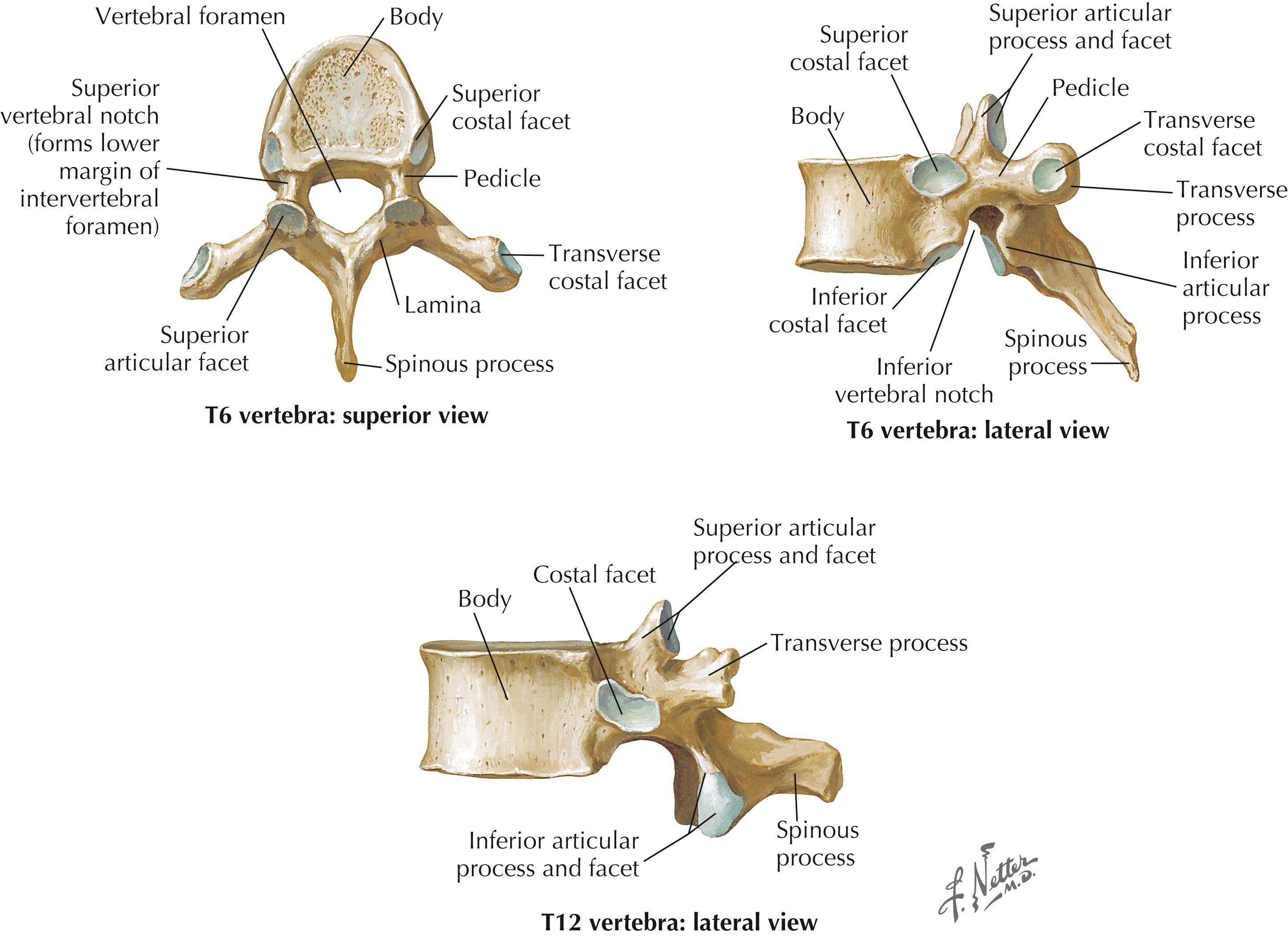
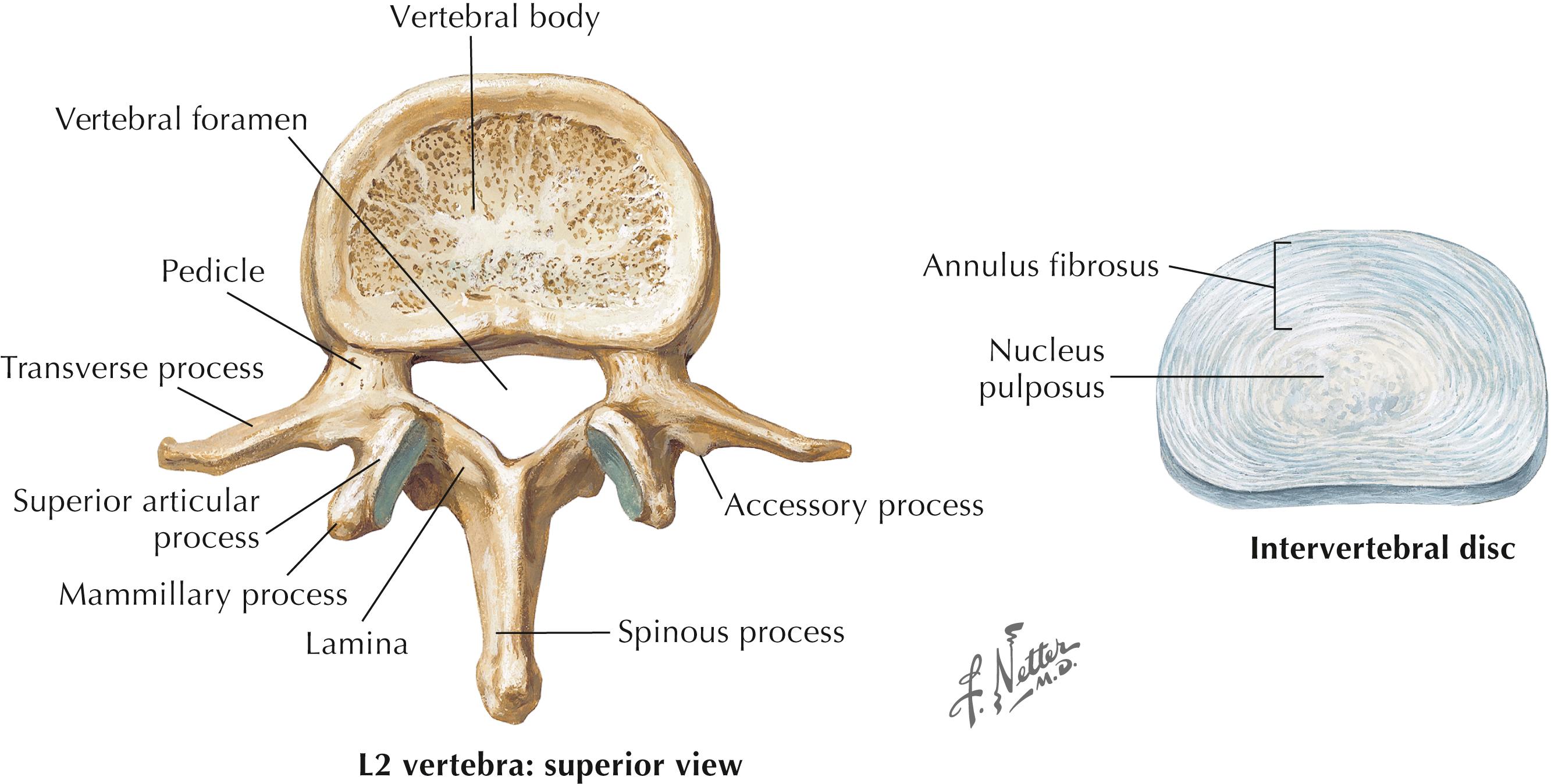
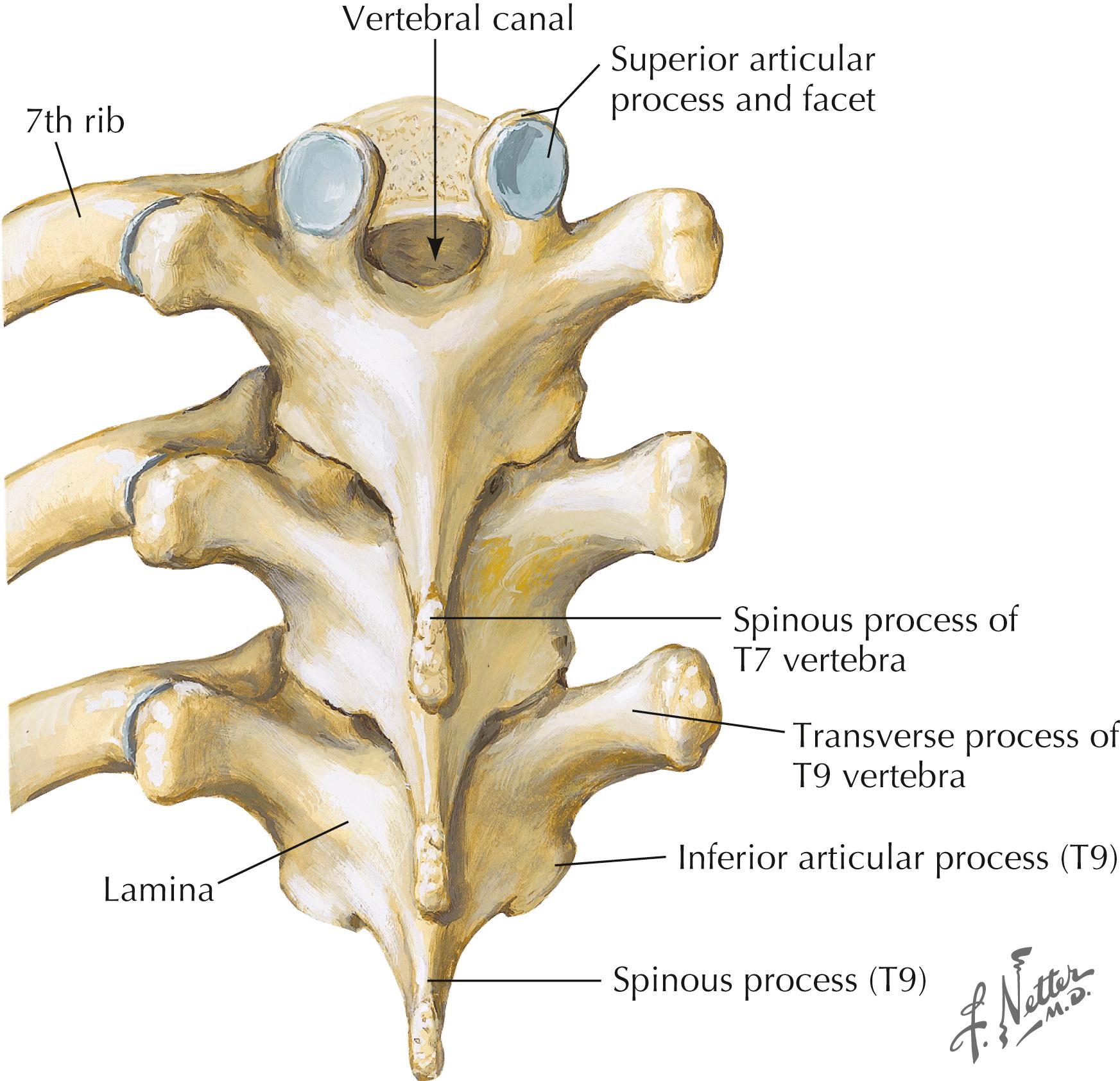
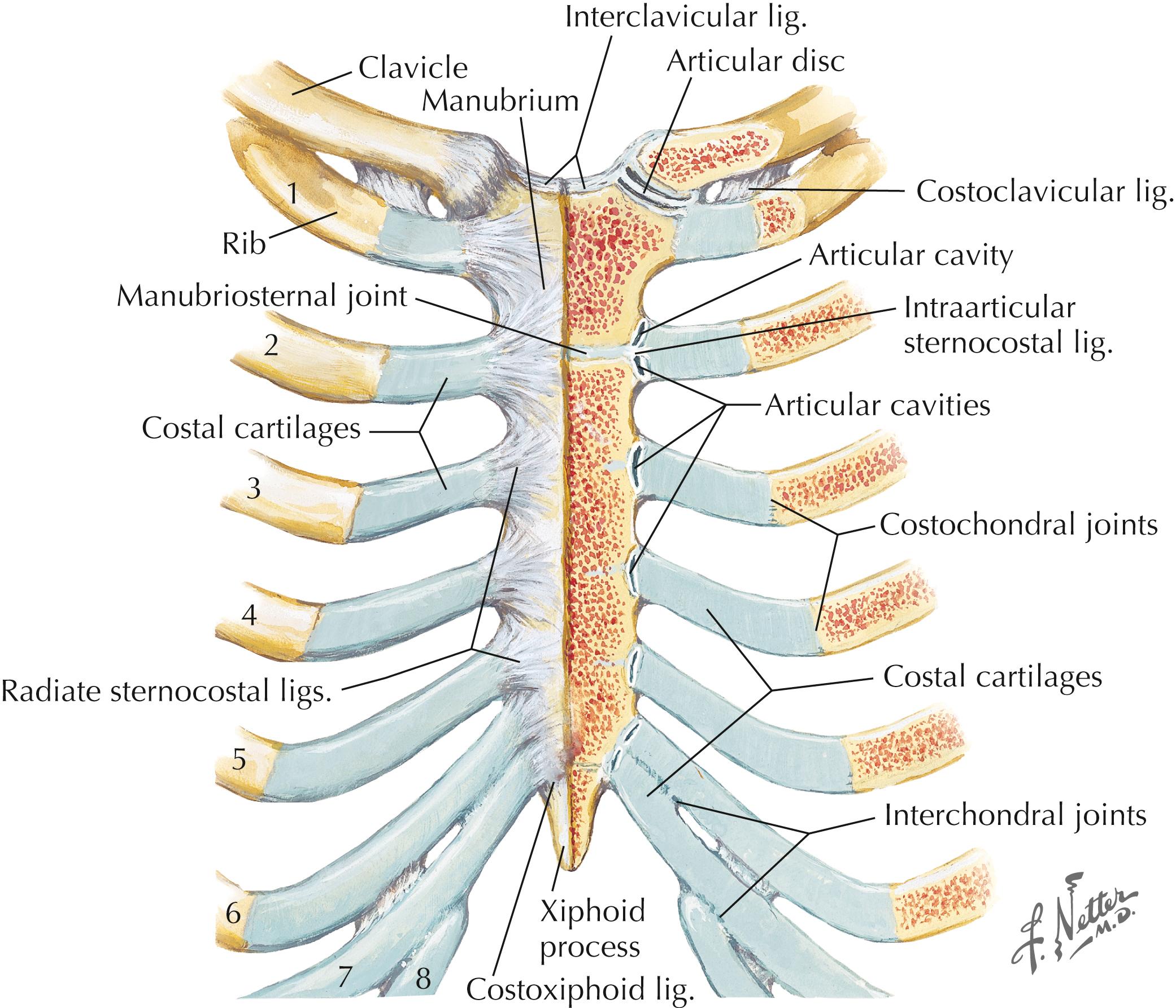
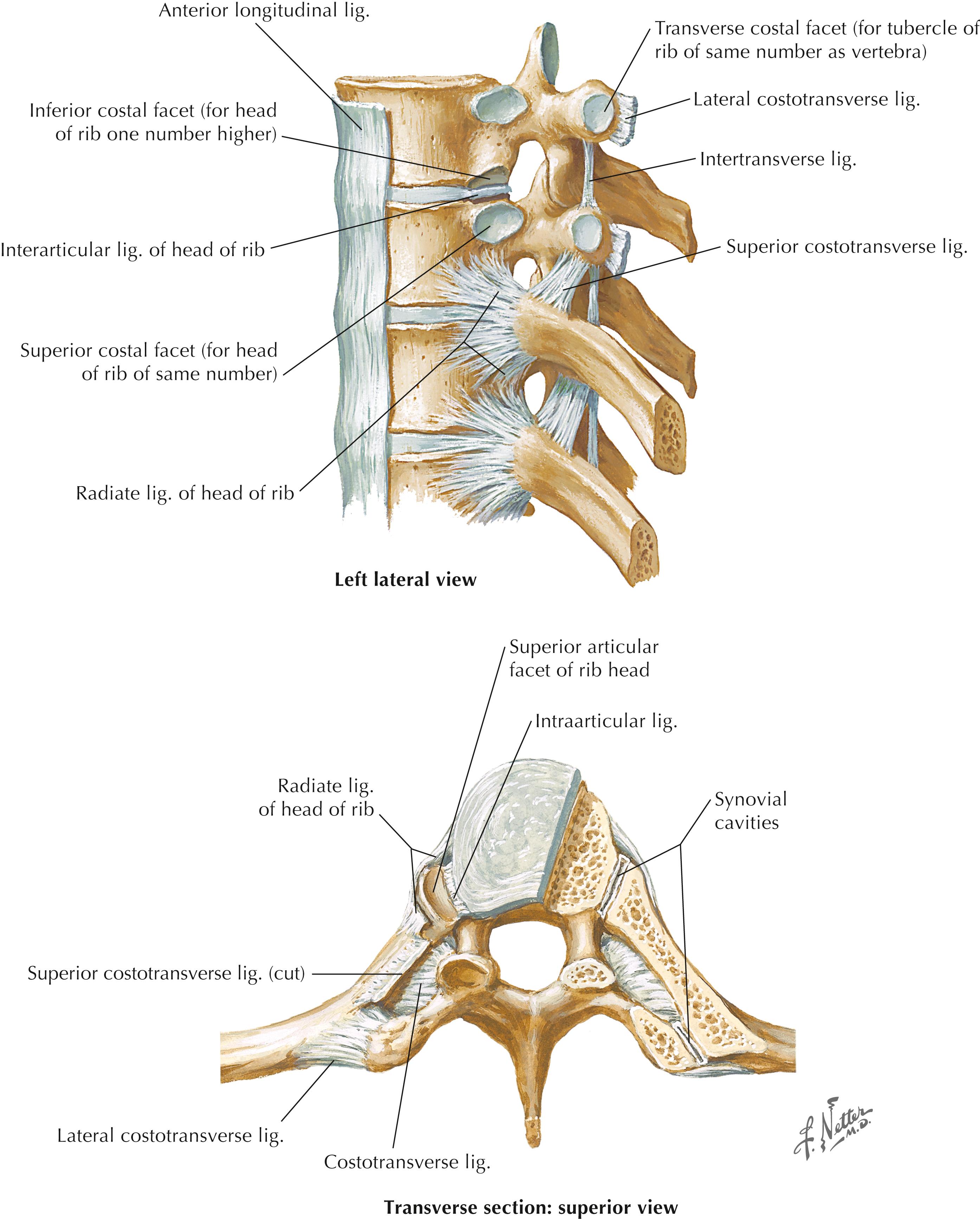
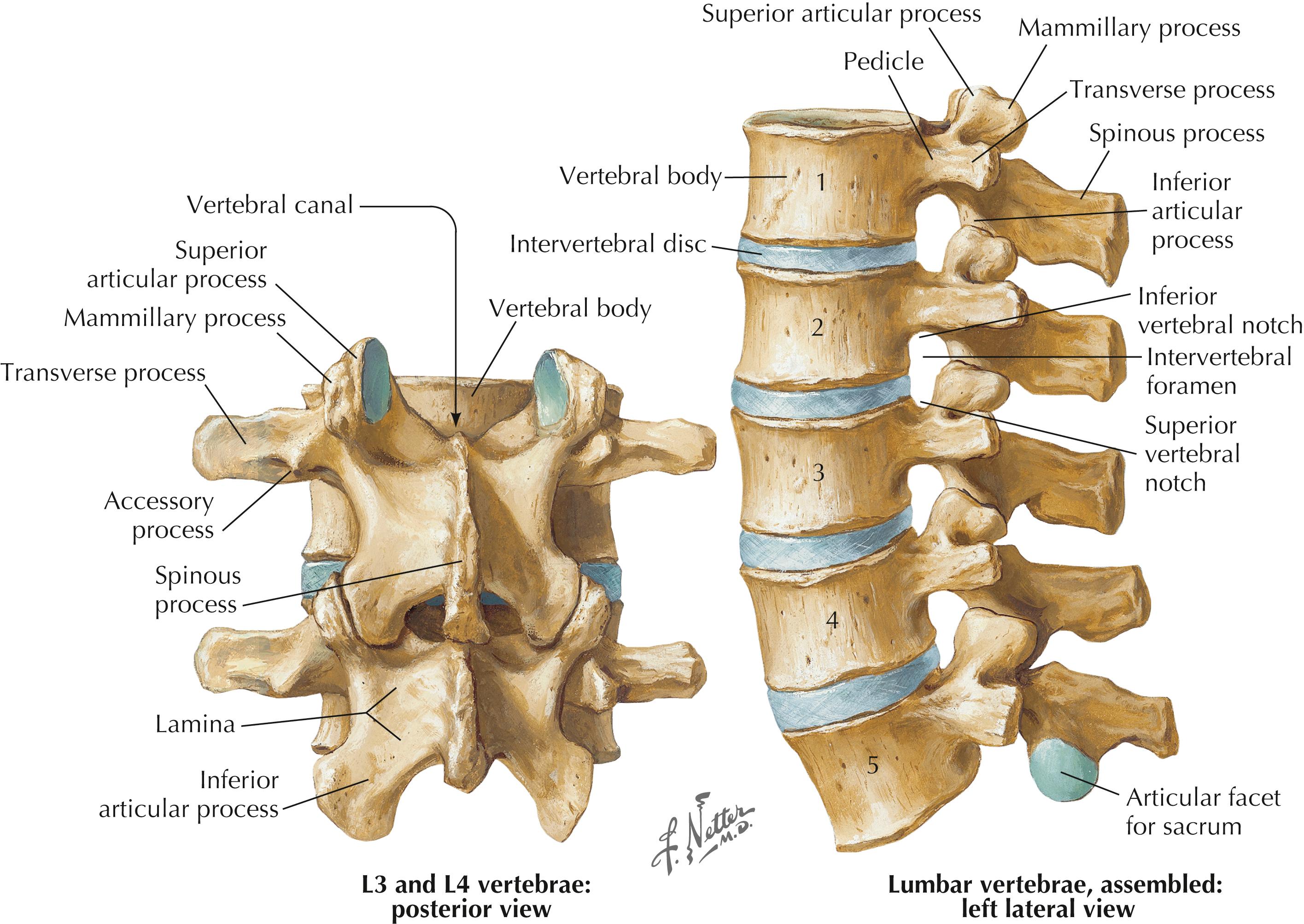
| Thoracolumbar Joints | Type and Classification | Closed Packed Position | Capsular Pattern |
|---|---|---|---|
| Zygapophyseal joints | Synovial: plane | Extension | Lumbar: significant limitation of side-bending bilaterally and limitations of flexion and extension Thoracic: limitation of extension, side-bending, and rotation; less limitation of flexion |
| Intervertebral joints | Amphiarthrodial | Not applicable | Not applicable |
| Thoracic Spine | Type and Classification | Closed Packed Position | Capsular Pattern |
|---|---|---|---|
| Costotransverse | Synovial | Not reported | Not reported |
| Costovertebral | Synovial | Not reported | Not reported |
| Costochondral | Synchondroses | Not reported | Not reported |
| Interchondral | Synovial | Not reported | Not reported |
| Sternocostal (first joint) | Amphiarthrodial | Not applicable | Not applicable |
| Sternocostal (second to seventh joints) | Synovial | Not reported | Not reported |
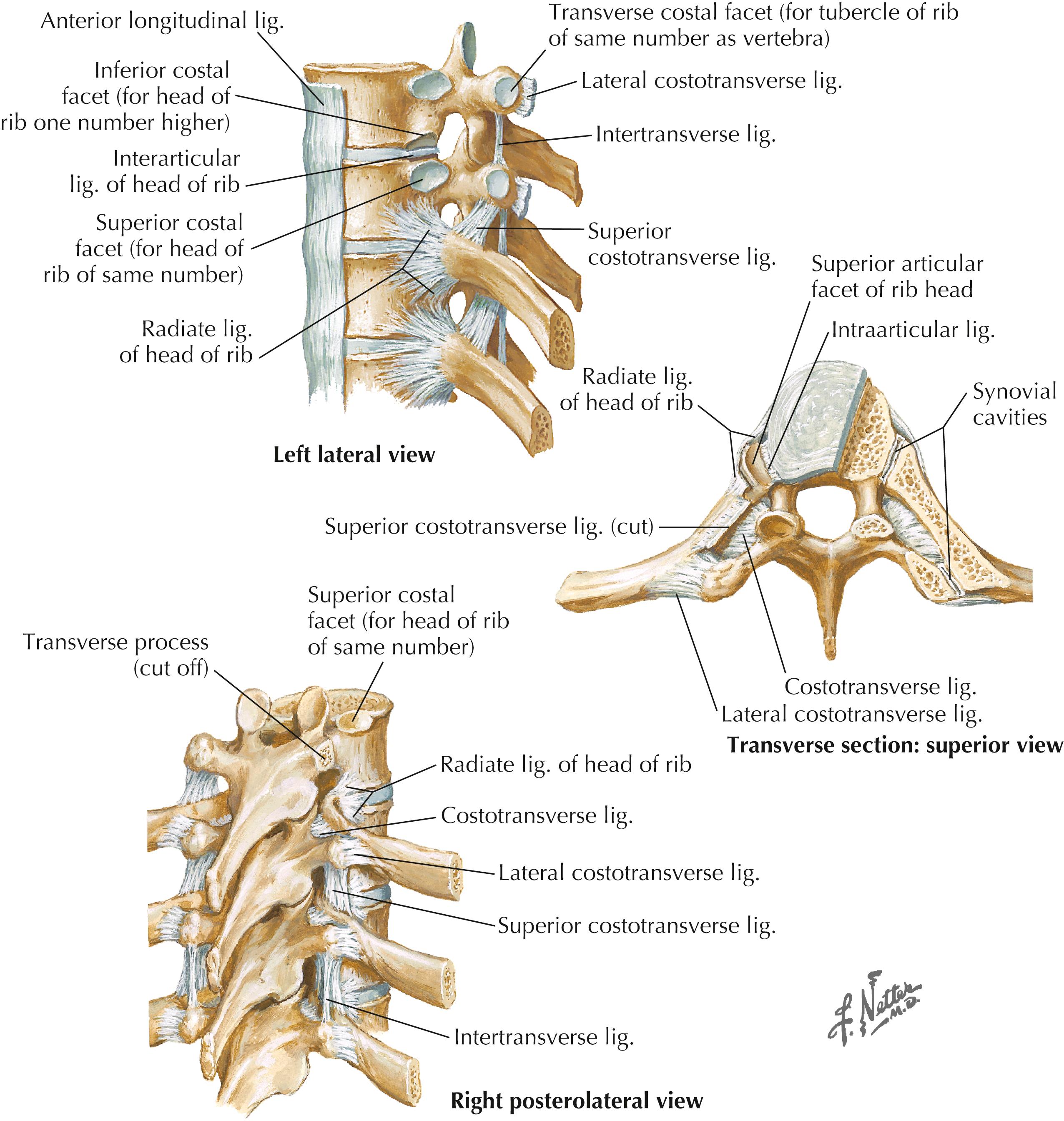
| Ligaments | Attachments | Function |
|---|---|---|
| Radiate sternocostal | Costal cartilage to the anterior and posterior aspects of the sternum | Reinforces joint capsule |
| Interchondral | Connect adjacent borders of articulations between costal cartilages 6 and 7, 7 and 8, and 8 and 9 | Reinforces joint capsule |
| Radiate ligament of head of rib | Lateral vertebral body to head of rib | Prevents separation of rib head from vertebra |
| Costotransverse | Posterior aspect of rib to anterior aspect of transverse process of vertebra | Prevents separation of rib from transverse process |
| Intraarticular | Crest of the rib head to intervertebral disc | Divides joint into two cavities |
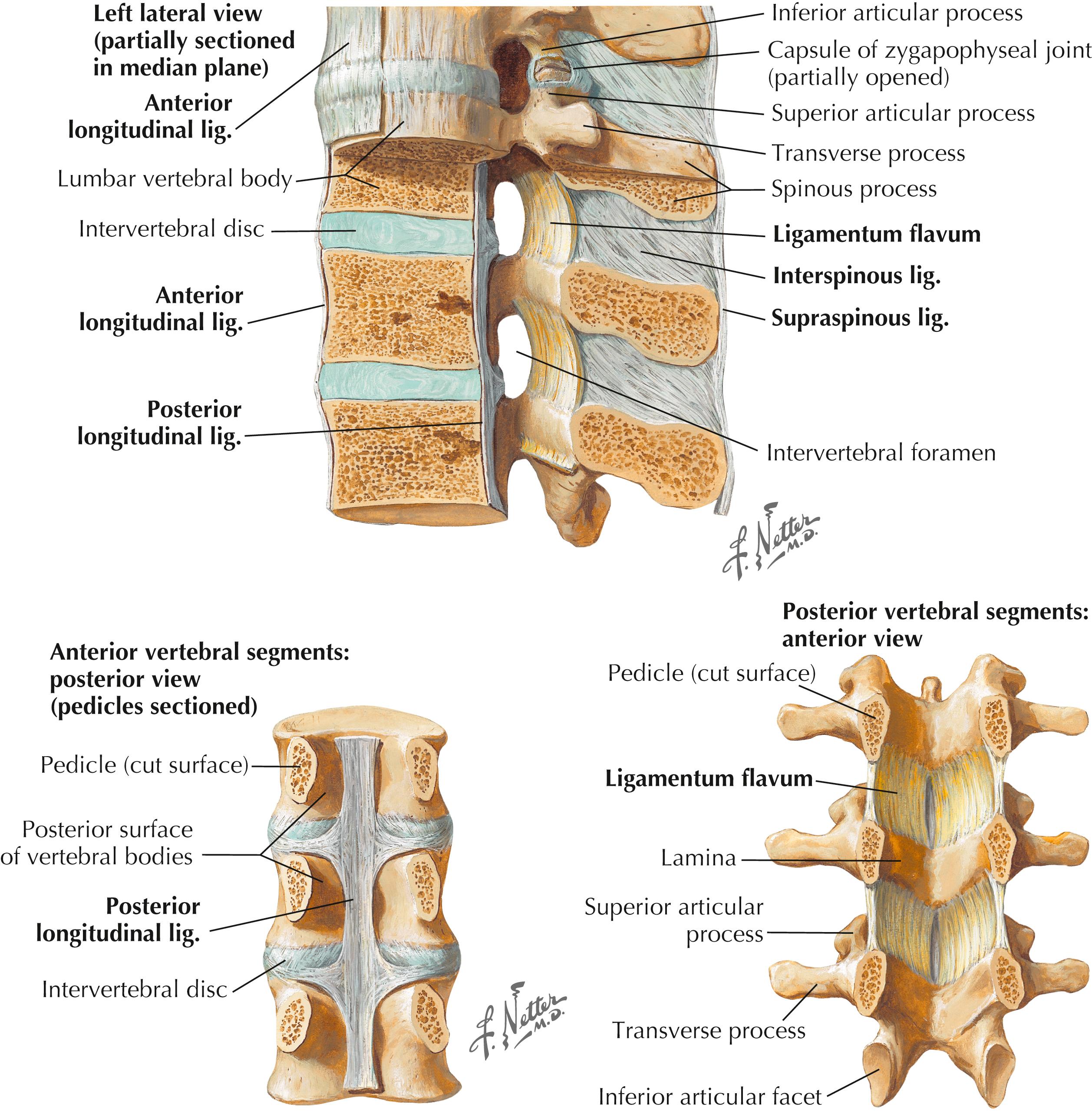
| Ligaments | Attachments | Function |
|---|---|---|
| Anterior longitudinal | Extends from anterior sacrum to anterior tubercle of C1. Connects anterolateral vertebral bodies and discs | Maintains stability and prevents excessive extension of spinal column |
| Posterior longitudinal | Extends from the sacrum to C2. Runs within the vertebral canal attaching the posterior vertebral bodies | Prevents excessive flexion of spinal column and posterior disc protrusion |
| Ligamenta flava | Binds the lamina above each vertebra to the lamina below | Prevents separation of the vertebral laminae |
| Supraspinous | Connect spinous processes of C7-S1 | Limits separation of spinous processes |
| Interspinous | Connect spinous processes of C1-S1 | Limits separation of spinous processes |
| Intertransverse | Connect adjacent transverse processes of vertebrae | Limits separation of transverse processes |
| Iliolumbar | Transverse processes of L5 to posterior aspect of iliac crest | Stabilizes L5 and prevents anterior shear |
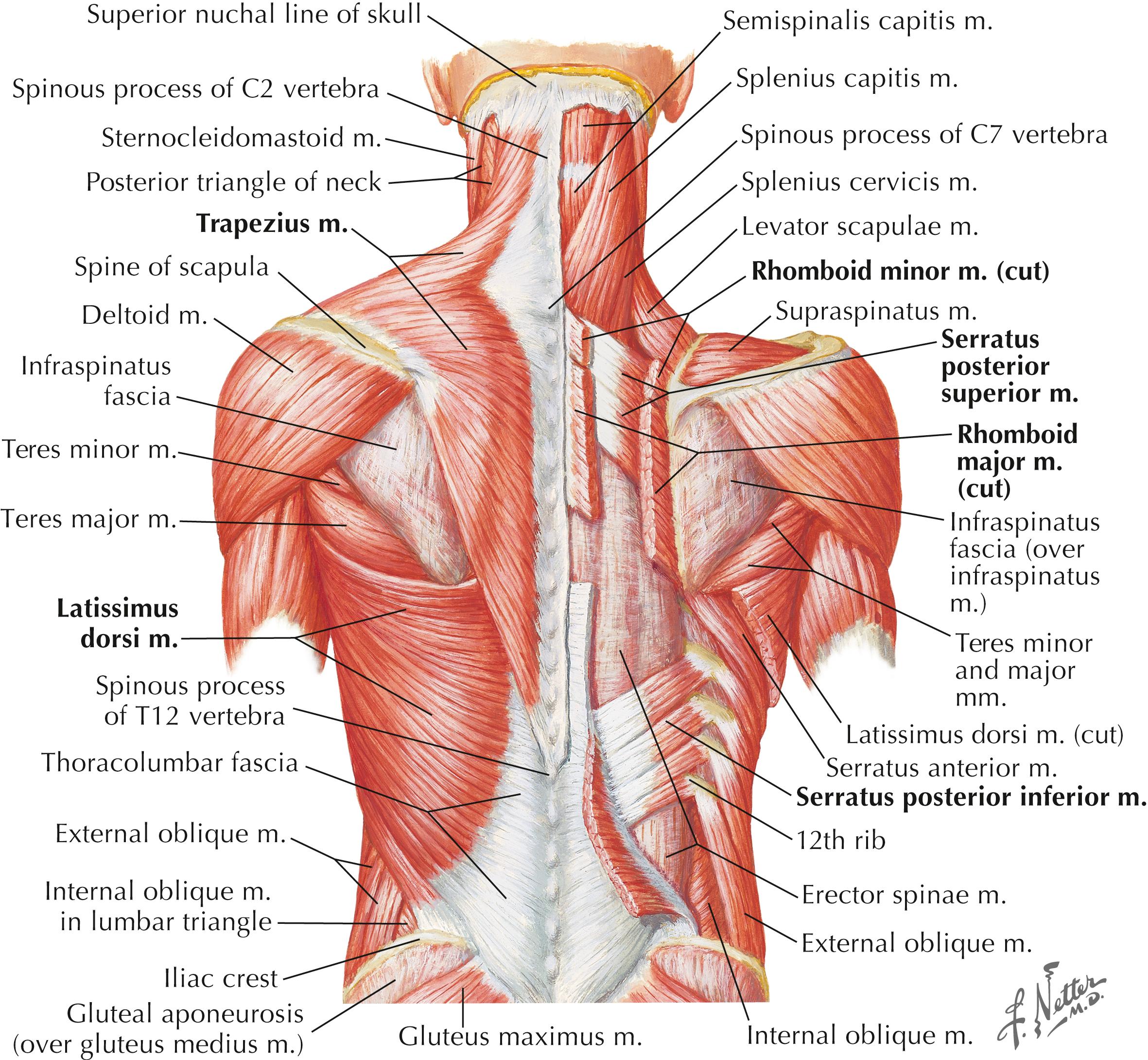
| Muscles | Proximal Attachment | Distal Attachment | Nerve and Segmental Level | Action |
|---|---|---|---|---|
| Latissimus dorsi | Spinous processes of T6-T12, thoracolumbar fascia, iliac crest, inferior four ribs | Intertubercular groove of humerus | Thoracodorsal nerve (C6, C7, C8) | Humerus extension, adduction, and internal rotation |
| Trapezius (middle) | Superior nuchal line, occipital protuberance, nuchal ligament, spinous processes of T1-T12 | Lateral clavicle, acromion, and spine of scapula | Accessory nerve (CN XI) | Retracts scapula |
| Trapezius (lower) | Depresses scapula | |||
| Rhomboid major | Spinous processes of T2-T5 | Inferior medial border of scapula | Dorsal scapular nerve (C4, C5) | Retracts scapula, inferiorly rotates glenoid fossa, stabilizes scapula to thoracic wall |
| Rhomboid minor | Spinous processes of C7-T1 and nuchal ligament | Superior medial border of scapula | ||
| Serratus posterior superior | Spinous processes of C7-T3, ligamentum nuchae | Superior surface of ribs 2-4 | Intercostal nerves 2-5 | Elevates ribs |
| Serratus posterior inferior | Spinous processes of T11-L2 | Inferior surface of ribs 8-12 | Ventral rami of thoracic spinal nerves 9-12 | Depresses ribs |
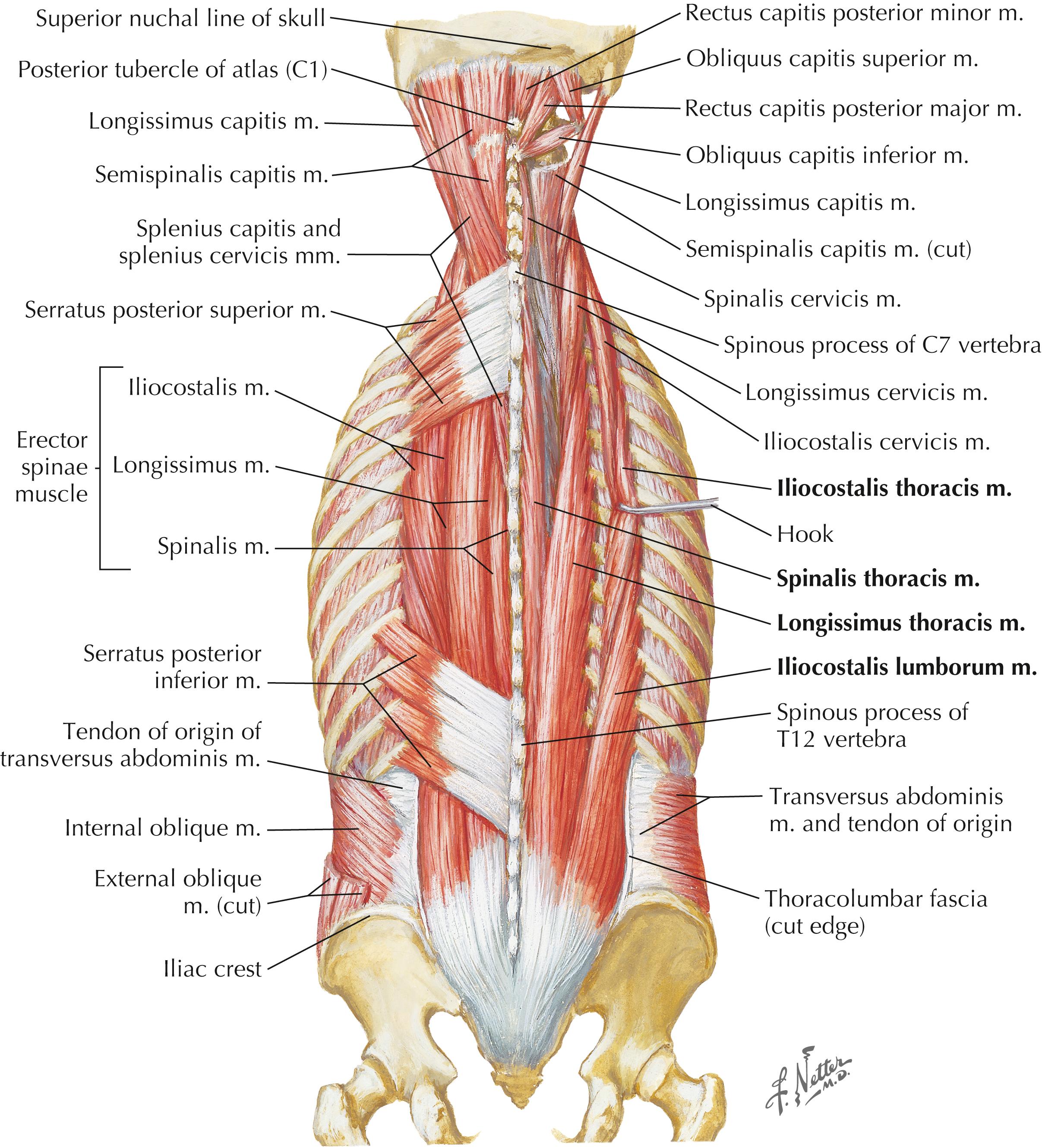
| Muscles | Proximal Attachment | Distal Attachment | Nerve and Segmental Level | Action |
|---|---|---|---|---|
| Iliocostalis thoracis | Iliac crest, posterior sacrum, spinous processes of sacrum and inferior lumbar vertebrae, supraspinous ligament | Cervical transverse processes and superior angles of lower ribs | Dorsal rami of spinal nerves | Bilaterally: extend spinal column Unilaterally: side-bend spinal column |
| Iliocostalis lumborum | Inferior surface of ribs 4-12 | |||
| Longissimus thoracis | Thoracic transverse processes and superior surface of ribs | |||
| Longissimus lumborum | Transverse process of lumbar vertebrae | |||
| Spinalis thoracis | Upper thoracic spinous processes |
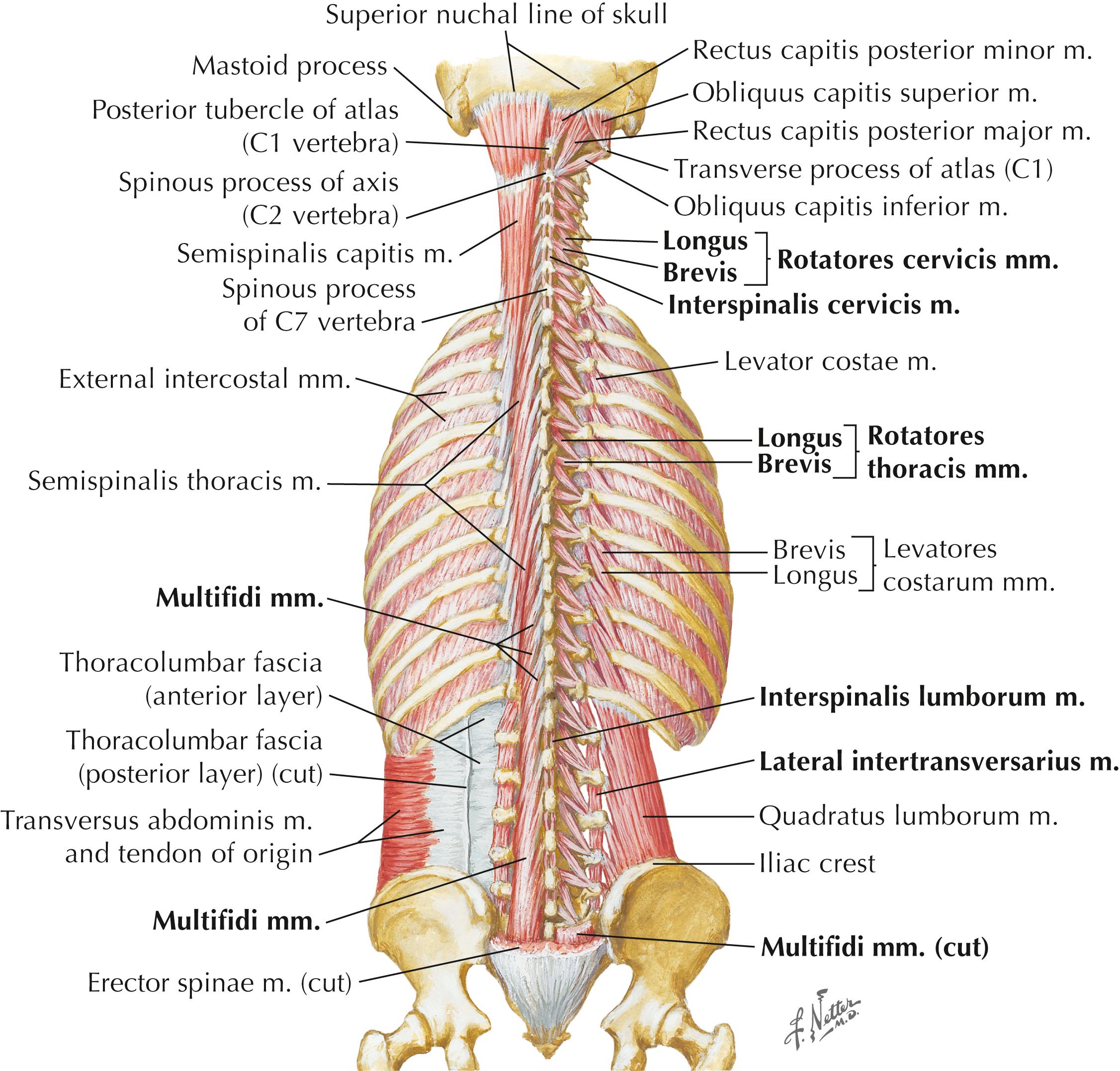
| Muscles | Proximal Attachment | Distal Attachment | Nerve and Segmental Level | Action |
|---|---|---|---|---|
| Rotatores | Transverse processes of vertebrae | Spinous process of vertebra one to two segments above origin | Dorsal rami of spinal nerves | Vertebral stabilization, assists with rotation and extension |
| Interspinalis | Superior aspect of cervical and lumbar spinous processes | Inferior aspect of spinous process superior to vertebrae of origin | Dorsal rami of spinal nerves | Extension and rotation of vertebral column |
| Intertransversarius | Cervical and lumbar transverse processes | Transverse process of adjacent vertebrae | Dorsal and ventral rami of spinal nerves | Bilaterally stabilizes vertebral column. Ipsilaterally side-bends vertebral column |
| Multifidi | Sacrum, ilium, transverse processes of T1-T3, articular processes of C4-C7 | Spinous process of vertebra two to four segments above origin | Dorsal rami of spinal nerves | Stabilizes vertebrae |
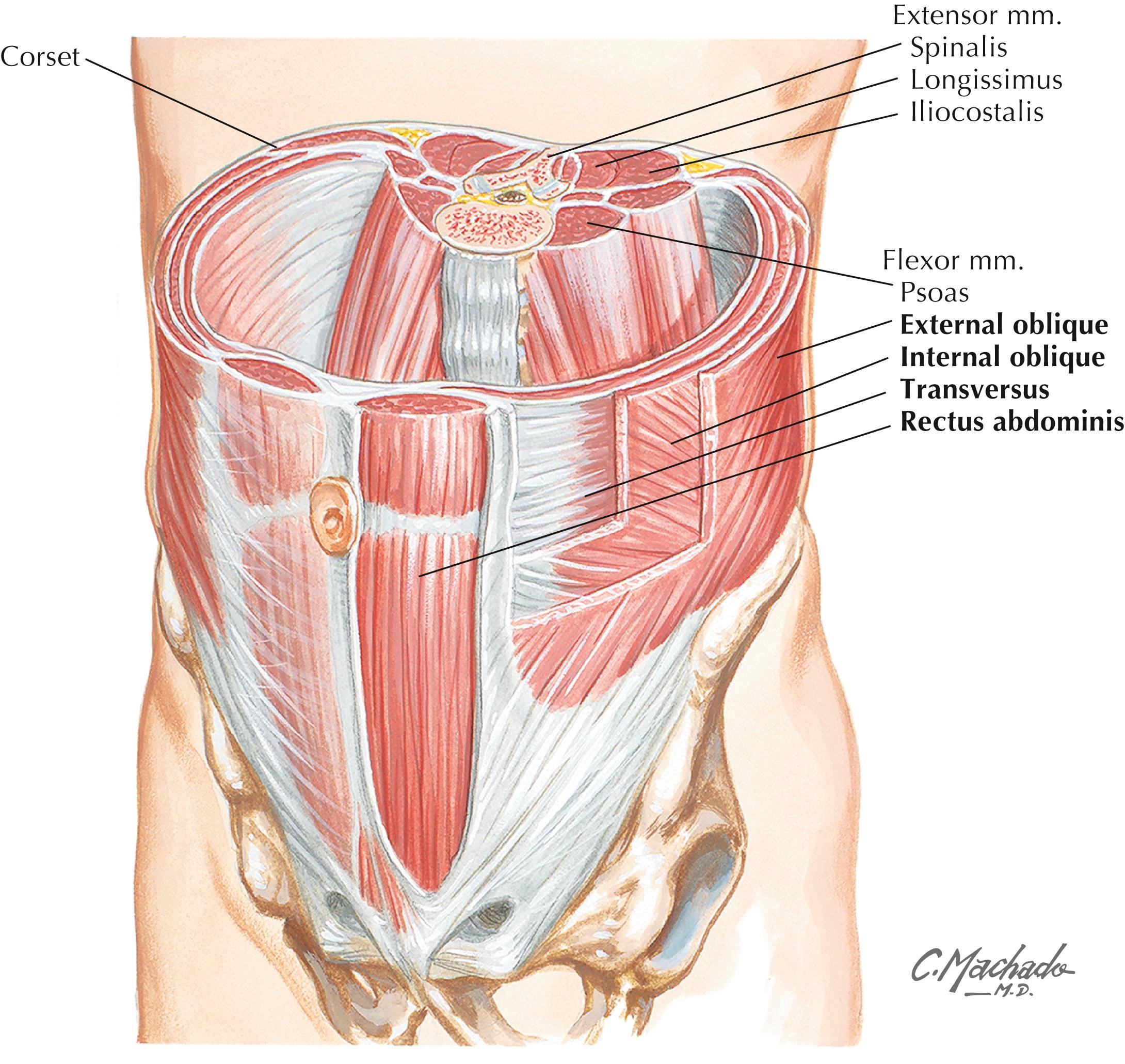
| Muscles | Proximal Attachment | Distal Attachment | Nerve and Segmental Level | Action |
|---|---|---|---|---|
| Rectus abdominis | Pubic symphysis and pubic crest | Costal cartilages 5-7 and xiphoid process | Ventral rami of T6-T12 | Flexes trunk |
| Internal oblique | Thoracolumbar fascia, anterior iliac crest, and lateral inguinal ligament | Inferior border of ribs 10-12, linea alba, and pecten pubis | Ventral rami of T6-L1 | Flexes and rotates trunk |
| External oblique | External aspects of ribs 5-12 | Anterior iliac crest, linea alba, and pubic tubercle | Ventral rami of T6-T12 and subcostal nerve | Flexes and rotates trunk |
| Transversus abdominis | Internal aspects of costal cartilages 7-12, thoracolumbar fascia, iliac crest, and lateral inguinal ligament | Linea alba, pecten pubis, and pubic crest | Ventral rami of T6-L1 | Supports abdominal viscera and increases intraabdominal pressure |
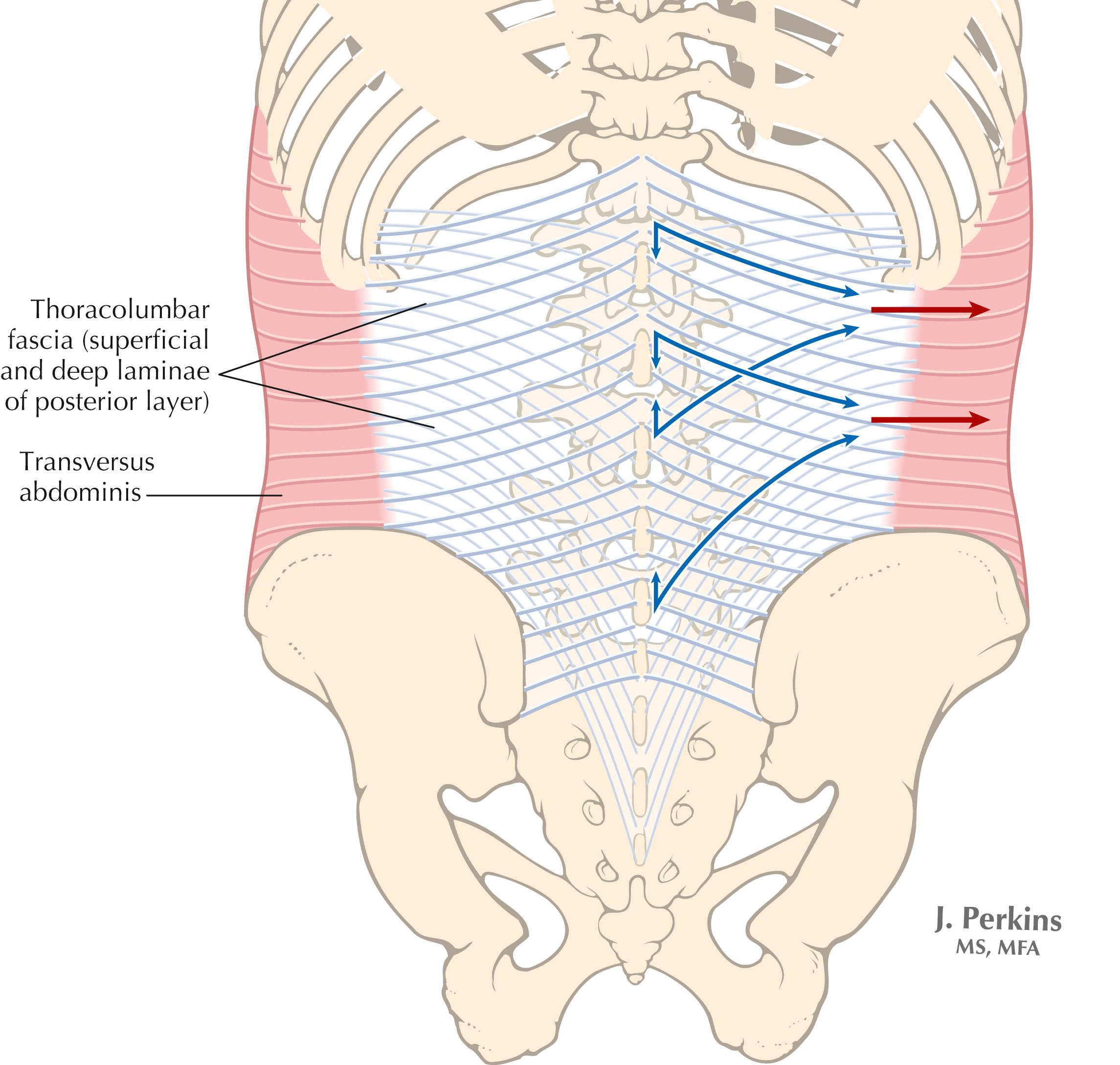
The thoracolumbar fascia is a dense layer of connective tissue running from the thoracic region to the sacrum. It is composed of three separate and distinct layers: anterior, middle, and posterior. The middle and posterior layers blend together to form a dense fascia referred to as the lateral raphe. The posterior layer consists of two distinctly separate laminae. The superficial lamina fibers are angled downward and the deep lamina fibers are angled upward. Bergmark has reported that the thoracolumbar fascia serves three purposes: (1) to transfer forces from muscles to the spine, (2) to transfer forces between spinal segments, and (3) to transfer forces from the thoracolumbar spine to the retinaculum of the erector spinae muscles. The transverse abdominis attaches to the middle layer of the thoracolumbar fascia and exerts a force through the lateral raphe, resulting in a cephalad tension through the deep layer and a caudal tension through the superficial layer of the posterior lamina. , , The result is a stabilizing force exerted through the lumbar spine, which has been reported to provide stability and assist with controlling intersegmental motion of the lumbar spine.
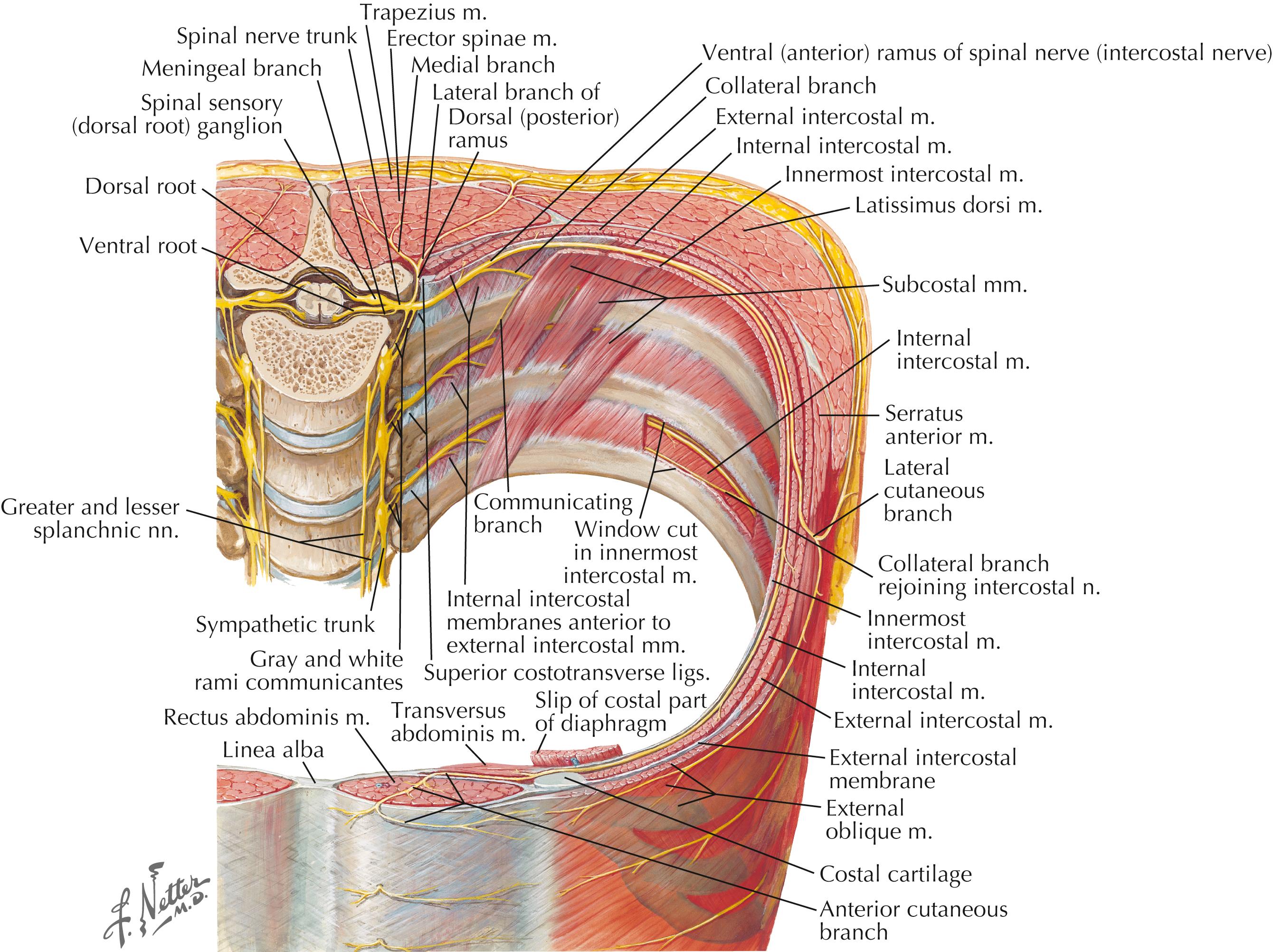
| Nerve Ventral Rami |
Segmental Level | Sensory | Motor |
|---|---|---|---|
| Intercostals | T1-T11 | Anterior and lateral aspect of the thorax and abdomen | Intercostals, serratus posterior, levator costarum, transversus thoracis |
| Subcostals | T12 | Part of external oblique | |
| Dorsal rami | T1- T12 | Posterior thorax and back | Splenius, iliocostalis, longissimus, spinalis, interspinales, intertransversarii, multifidi, semispinalis, rotatores |
| Subcostal nerve | T12 | Lateral hip | External oblique |
| Iliohypogastric nerve | T12, L1 | Posterolateral gluteal region | Internal oblique, transverse abdominis |
| Ilioinguinal | L1 | Superior medial thigh | Internal oblique, transverse abdominis |
| Genitofemoral | L1, L2 | Superior anterior thigh | No motor |
| Lateral cutaneous | L2, L3 | Lateral thigh | No motor |
| Branch to iliacus | L2, L3, L4 | No sensory | Iliacus |
| Femoral nerve | L2, L3, L4 | Thigh via cutaneous nerves | Iliacus, sartorius, quadriceps femoris, articularis genu, pectineus |
| Obturator nerve | L2, L3, L4 | Medial thigh | Adductor longus, adductor brevis, adductor magnus (adductor part), gracilis, obturator externus |
| Sciatic | L4, L5, S1, S2, S3 | Hip joint | Knee flexors and all muscles of the lower leg and foot |
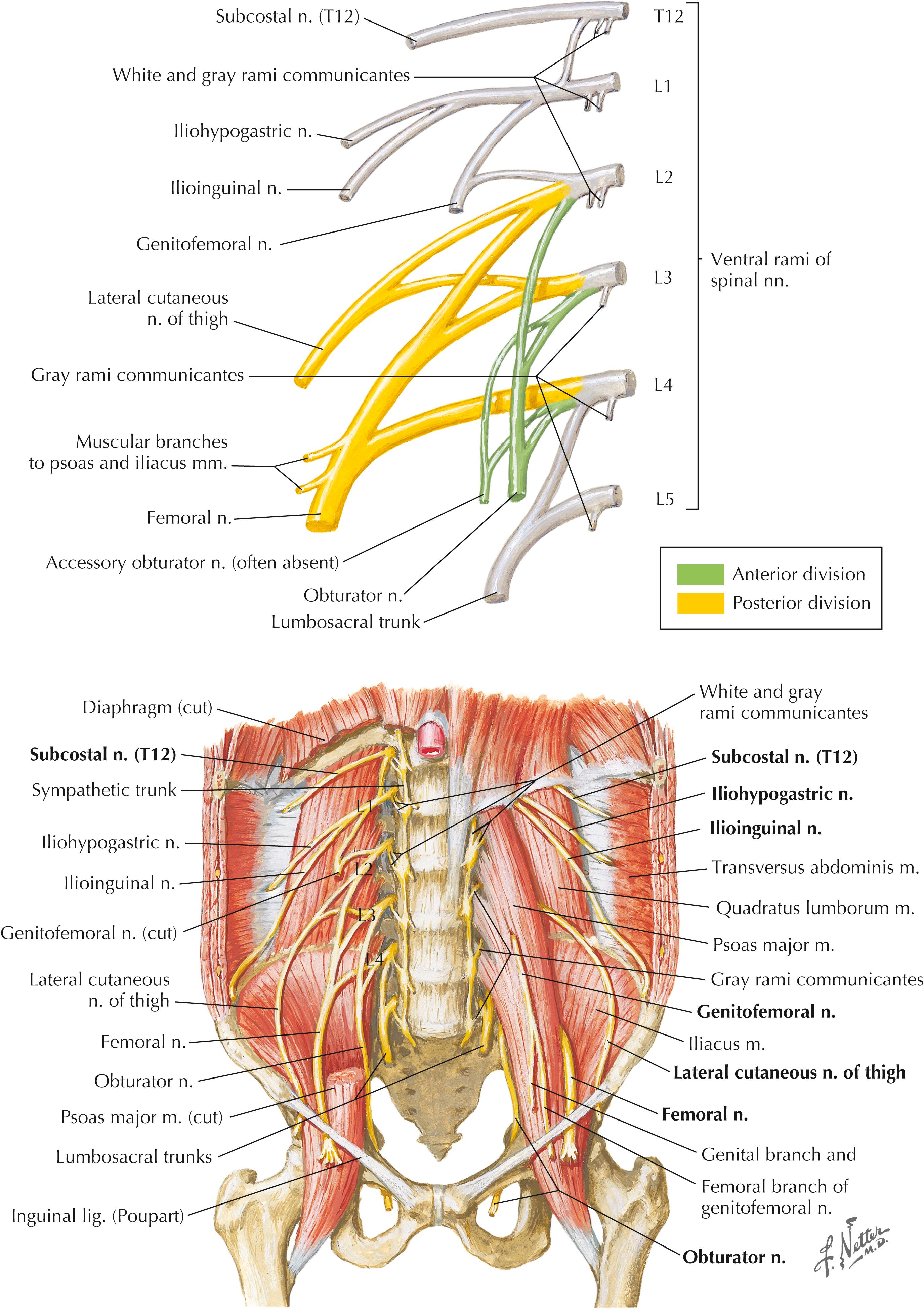
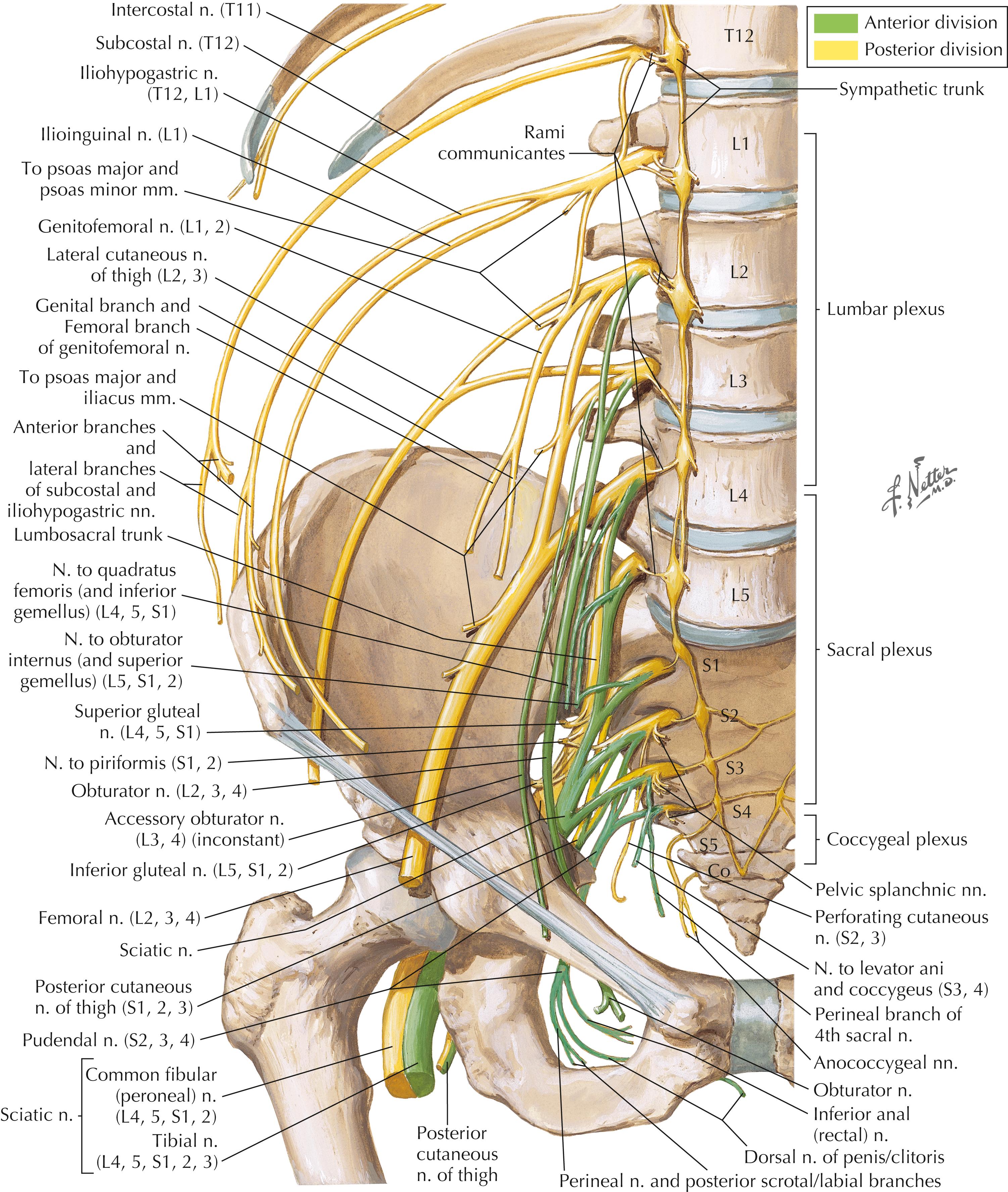
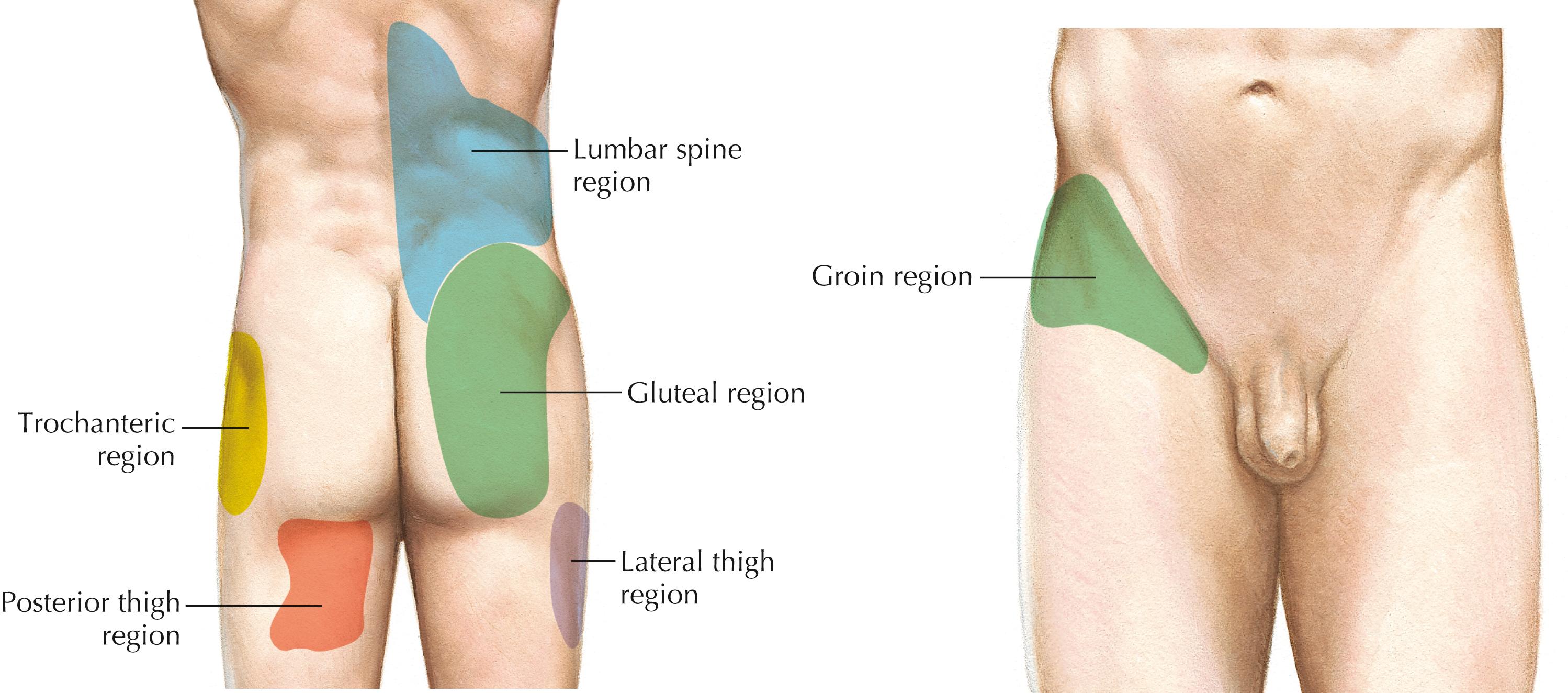
| Area of Pain Referral | Percentage of Patients Presenting with Pain (n = 176 Patients with Low Back Pain) ∗ |
|---|---|
| Left groin | 15% |
| Right groin | 3% |
| Left buttock | 42% |
| Right buttock | 15% |
| Left thigh | 38% |
| Right thigh | 38% |
| Left calf | 27% |
| Right calf | 15% |
| Left foot | 31% |
| Right foot | 8% |
∗ Prevalence of pain referral patterns in patients with zygapophyseal joint pain syndromes as confirmed by diagnostic blocks. In a subsequent study, it was determined that in a cohort of 63 patients with chronic low back pain, the prevalence of zygapophyseal joint pain was 40%.
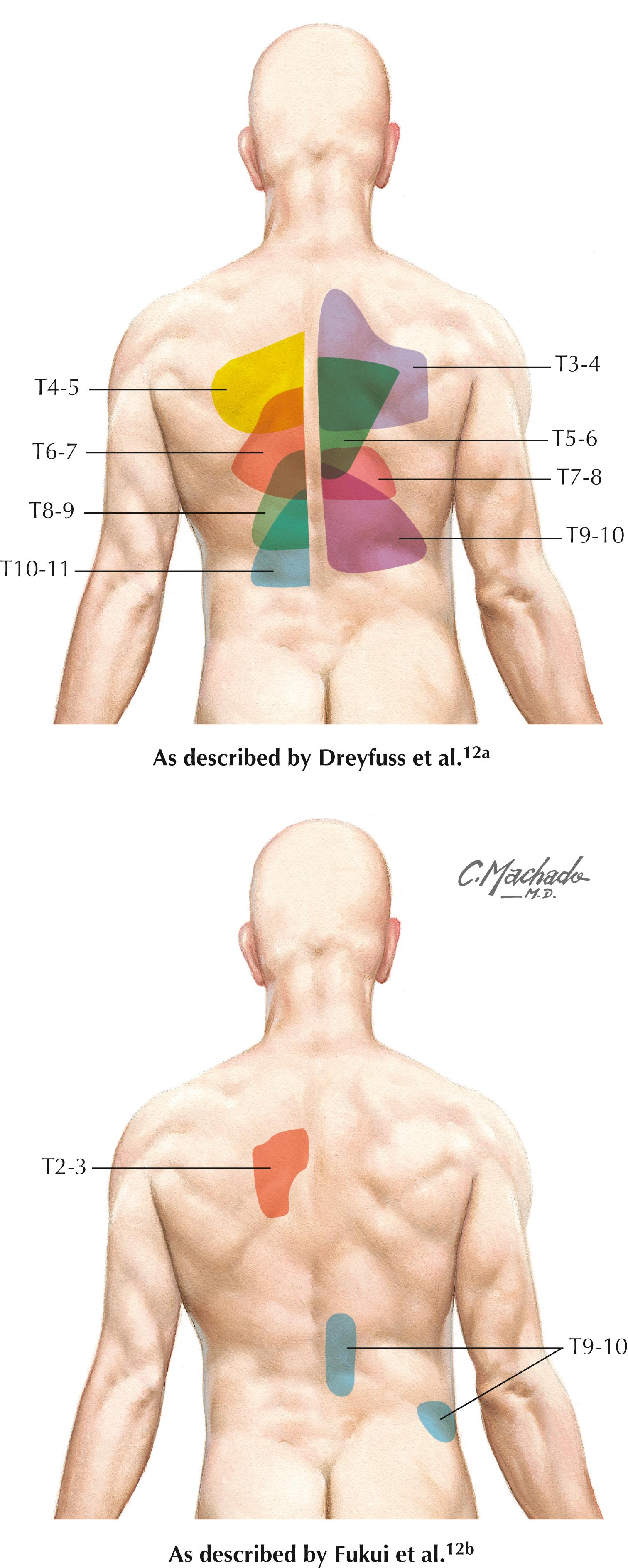
| Historical Question and Study Quality | Population | Reliability | |
|---|---|---|---|
| Increased pain with |
Sitting | A random selection of 91 patients with low back pain | Interexaminer κ = .49 |
| Standing | Interexaminer κ = 1.0 | ||
| Walking | Interexaminer κ = .56 | ||
| Lying down | Interexaminer κ = .41 | ||
| Pain with sitting |
95 patients with low back pain | Interexaminer κ = .99 to 1.0 | |
| Pain with bending |
Interexaminer κ = .98 to .99 | ||
| Increased pain with coughing/sneezing15 |
A random selection of 91 patients with low back pain | Interexaminer κ = .64 | |
| Patient report of |
Foot pain | Two separate groups of patients with low back pain (n 1 = 50, n 2 = 33) | Interexaminer κ = .12 to .73 |
| Leg pain | Interexaminer κ = .53 to .96 | ||
| Thigh pain | Interexaminer κ = .39 to .78 | ||
| Buttock pain | Interexaminer κ = .33 to .44 | ||
| Back pain | Interexaminer κ = −.19 to .16 | ||
| Increased pain with |
Sitting | 53 subjects with a primary complaint of low back pain | Test-retest κ = .46 |
| Standing | Test-retest κ = .70 | ||
| Walking | Test-retest κ = .67 | ||
| Pain with bending |
53 subjects with a primary complaint of low back pain | Test-retest κ = .65 | |
| Pain with bending |
Two separate groups of patients with low back pain (n 1 = 50, n 2 = 33) | Interexaminer κ = .51 to .56 | |
| Increased pain with coughing |
53 subjects with a primary complaint of low back pain | Test-retest κ = .75 | |
| Pain with pushing/lifting/carrying |
Test-retest κ = .77 to .89 | ||
| Historical Question and Study Quality | Patient Population | Reference Standard | Sens | Spec | +LR | −LR |
|---|---|---|---|---|---|---|
| Age ≥ 75 |
669 patients >55 years of age seen in primary care for 1st episode of low back pain with or without leg pain | Radiologic diagnosis of vertebral fracture | .45 (.28, .62) | .85 (.82, .88) | 3.1 (2.0, 4.7) | .60 (.50, .90) |
| Trauma |
.21 (.07, .35) | .97 (.95, .98) | 6.2 (2.8, 13.5) | .80 (.50, 1.3) | ||
| Osteoporosis |
.38 (.21, .54) | .88 (.86, .91) | 3.2 (1.9, 5.2) | .70, (.50, .90) | ||
| Back pain intensity score ≥7/10 |
.67 (.51, .83) | .63 (.59, .67) | 1.8 (1.4, 2.3) | .50 (.30, .90) | ||
| Thoracic back pain |
.42 (.26, .59) | .78 (.75, .81) | 1.9 (1.3, 3.0) | .70 (.50, 1.0) | ||
| ≥1/5 of above features |
.88 (.77, .99) | .42 (.38, .46) | 1.5 (1.3, 1.8) | .30 (.10, .70) | ||
| ≥2/5 of above features |
.70 (.54, .85) | .81 (.78, .84) | 3.6 (2.8, 4.8) | .40 (.20, .60) | ||
| ≥3/5 of above features |
.30 (.15, .46) | .95 (.93, .97) | 5.8 (3.2, 10.8) | .70 (.60, .90) | ||
Any of the following 4 factors:
|
329 adult patients presenting to emergency department with nontraumatic low back pain | Serious outcome as the identification of any one of the following underlying pathologies within 30 days of the initial visit: compression fracture, osteomyelitis, spinal abscess, malignancy, cauda equina syndrome, severe disc prolapse requiring surgery, any condition requiring immediate intervention (i.e., abdominal aortic aneurysm, retroperitoneal tumor, bleeding or infection that required treatment, spinal stenosis requiring surgery, or death) | .91 (.71, .99) | .55 (.49, .61) | 2.0 (1.7, 2.4) | .17 (.04, .62) |
| Historical Question and Study Quality | Patient Population | Reference Standard | Sens | Spec | +LR | −LR |
|---|---|---|---|---|---|---|
| Age over 65 years |
93 patients with low back pain 40 years old or older | Lumbar spinal stenosis per attending physician’s impression; 88% also supported by computed tomography (CT) or magnetic resonance imaging (MRI) | .77 (.64, .90) | .69 (.53, .85) | 2.5 | .33 |
| Pain below knees? |
.56 (.41, .71) | .63 (.46, .80) | 1.5 | .70 | ||
| Pain below buttocks? |
.88 (.78, .98) | .34 (.18, .50) | 1.3 | .35 | ||
| No pain when seated? |
.46 (.30, .62) | .93 (.84, 1.0) | 6.6 | .58 | ||
| Severe lower extremity pain? |
.65 (.51, .79) | .67 (.51, .83) | 2.0 | .52 | ||
| Symptoms improved while seated? |
.52 (.37, .67) | .83 (.70, .96) | 3.1 | .58 | ||
| Worse when walking? |
.71 (.57, .85) | .30 (.14, .46) | 1.0 | .97 | ||
| Numbness |
.63 (.49, .74) | .59 (.42, .76) | 1.5 | .63 | ||
| Poor balance |
.70 (.56, .84) | .53 (.36, .70) | 1.5 | .57 | ||
| Do you get pain in your legs with walking that is relieved by sitting? |
45 patients with low back and leg pain and self-reported limitations in walking tolerance | Lumbar spinal stenosis per MRI or CT imaging | .81 (.66, .96) | .16 (.00, .32) | .82 (.63, 1.1) | 1.27 |
| Are you able to walk better when holding onto a shopping cart? |
.63 (.42, .85) | .67 (.40, .93) | 1.9 (.80, 4.5) | .55 | ||
| Sitting reported as best posture with regard to symptoms |
.89 (.76, 1.0) | .39 (.16, .61) | 1.5 (.90, 2.4) | .28 | ||
| Walking/standing reported as worst posture with regard to symptoms |
.89 (.76, 1.0) | .33 (.12, .55) | 1.3 (.80, 2.2) | .33 |
| Historical Question and Study Quality | Patient Population | Reference Standard | Sens | Spec | +LR | −LR |
|---|---|---|---|---|---|---|
| Patient reports of: | 170 patients with low back and leg symptoms | Lumbosacral radiculopathy per electrodiagnostics | ||||
| Weakness |
.70 | .41 | 1.19 | .73 | ||
| Numbness |
.68 | .34 | 1.03 | .94 | ||
| Tingling |
.67 | .31 | .97 | 1.06 | ||
| Burning |
.40 | .60 | 1.0 | 1.0 |
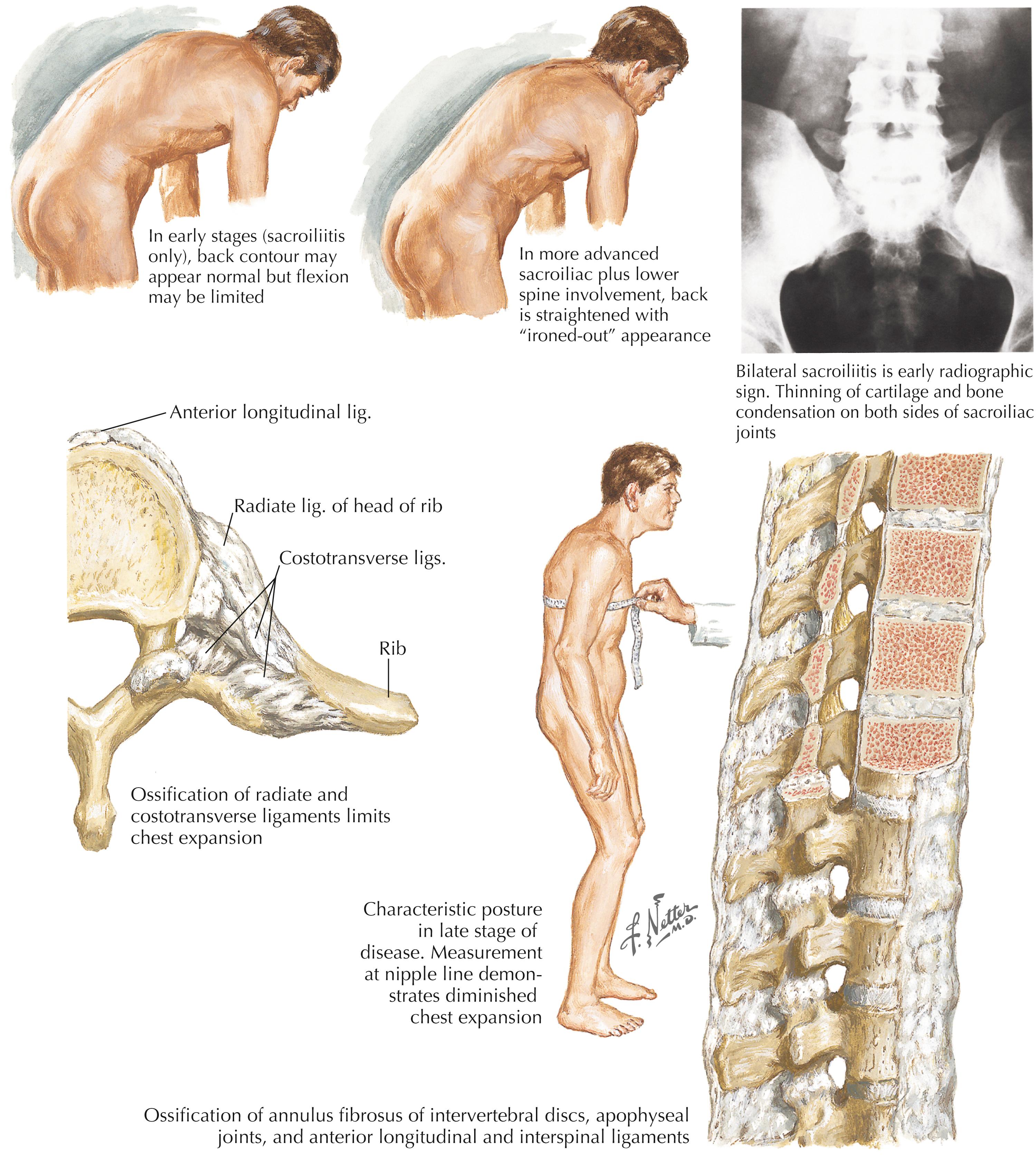
| Clinical Symptom and Study Quality | Patient Population | Reference Standard | Sens | Spec | +LR | −LR |
|---|---|---|---|---|---|---|
| Pain not relieved by lying down |
449 randomly selected patients with low back pain | The New York criteria and radiographic confirmation of ankylosing spondylitis | .80 | .49 | 1.57 | .41 |
| Back pain at night |
.71 | .53 | 1.51 | .55 | ||
| Morning stiffness for longer than ½ hour |
.64 | .59 | 1.56 | .68 | ||
| Pain or stiffness relieved by exercise |
.74 | .43 | 1.30 | .60 | ||
| Age of onset 40 years or less |
1.0 | .07 | 1.07 | .00 |
| Test and Study Quality | Description and Positive Findings | Population | Reference Standard | Sens | Spec | +LR | −LR | |
|---|---|---|---|---|---|---|---|---|
| Sensation (vibration and pinprick) |
Considered abnormal when either vibration or pinprick was reduced on the side of the lesion | 170 patients with low back and lower extremity symptoms | Electrodiagnostic testing. Radiculopathy defined as the presence of positive sharp waves; fibrillation potentials; complex repetitive discharges; high-amplitude, long-duration motor unit potentials; reduced recruitment; or increased polyphasic motor unit potentials (of more than 30%) in two or more muscles innervated by the same nerve root level but different peripheral nerves | .50 | .62 | 1.32 | .81 | |
| Weakness |
Gastrocnemius and soleus | Weakness was defined as any grade of less than 5/5 | S1 = .47 | S1 = .76 | 1.96 | .70 | ||
| Extensor hallucis longus | L5 = .61 | L5 = .55 | 1.36 | .71 | ||||
| Hip flexors | L3-L4 = .70 | L3-L4 = .84 | 4.38 | .36 | ||||
| Quadriceps | L3-L4 = .40 | L3-L4 = .89 | 3.64 | .67 | ||||
| Reflexes |
Achilles | Considered abnormal when the reflex on the side of the lesion was reduced compared with the opposite side | S1 = .47 | S1 = .9 | 4.70 | .59 | ||
| Patellar | L3-L4 = .50 | L3-L4 = .93 | 7.14 | .54 | ||||
| Reflexes |
Achilles | Test is positive if reflex is absent | 100 patients with lumbar disc herniation diagnosed by MRI | Lumbar disc herniation diagnosed by MRI with level of herniation intraoperatively confirmed | S1 = .83 | S1 = .57 | 1.93 | .30 |
| Medial hamstring | L5 = .76 | L5 = .85 | 5.07 | .28 | ||||
| Patellar | L3-L4 = .88 | L3-L4 = .86 | 6.29 | .14 | ||||
| Reflexes + Weakness + Sensory |
All three abnormal | 170 patients with low back and lower extremity symptoms | Electrodiagnostic testing. Radiculopathy defined as the presence of positive sharp waves; fibrillation potentials; complex repetitive discharges; high-amplitude, long-duration motor unit potentials; reduced recruitment; or increased polyphasic motor unit potentials (of more than 30%) in two or more muscles innervated by the same nerve root level but different peripheral nerves | .12 | .97 | 4.00 | .91 | |
| Reflexes + Weakness + Sensory + Straight-leg raise test |
All four abnormal | .06 | .99 | 6.00 | .95 | |||
| Any of four abnormal | .87 | .35 | 1.34 | .37 | ||||
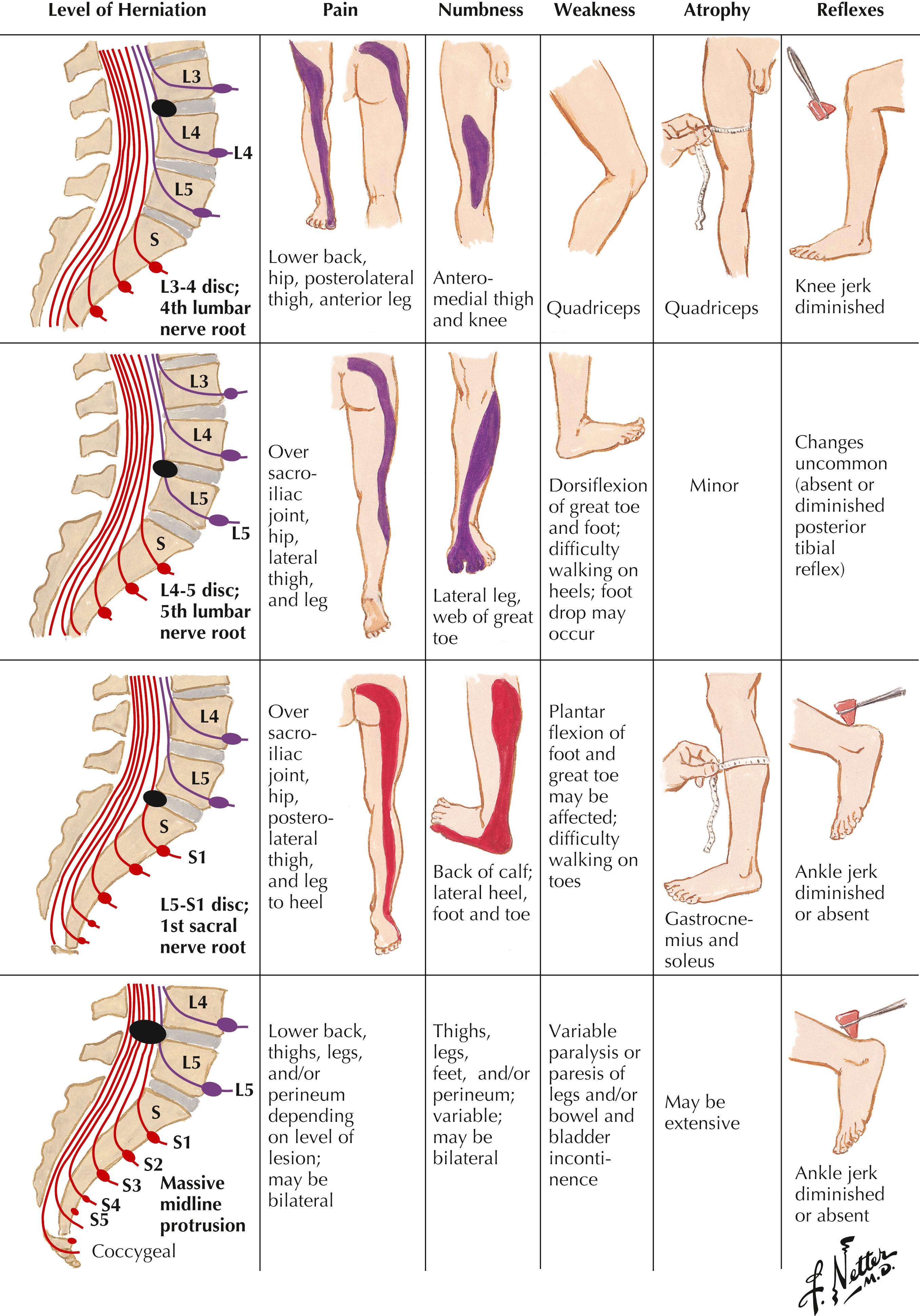
Become a Clinical Tree membership for Full access and enjoy Unlimited articles
If you are a member. Log in here